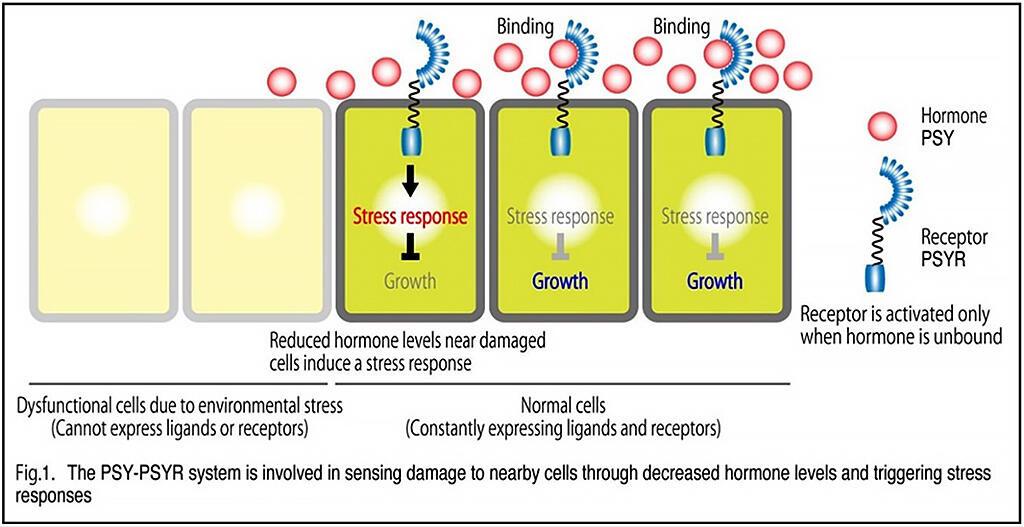A research group consisting of Professor Yoshikatsu Matsubayashi and Assistant Professor Mari Ogawa-Ohnishi of the Graduate School of Science, Nagoya University and their colleagues has announced their discovery of the peptide hormone family PSY, which mediate the switch between stress response and growth in plants, and their receptors PSYRs. They used Arabidopsis thaliana (thale cress) to analyze these hormones and their receptors, and clarified that these turn the stress response on and off. The mechanism by which plants turn part of their growth energy into a stress response according to circumstances as a way of adapting to stresses such as diseases, has become clear. It is hoped that this will lead to the creation of crops with an optimal balance between stress tolerance and yield. These outcomes were published in the October 14 version of the international science journal Science.

In their natural environment, plants have a mechanism that allows them to turn part of their limited energy into a stress response according to their circumstances, as a way of adapting to stresses such as disease, temperature, and salt levels. Once they sense the stress, they use energy to cope with it - e.g. to create resistance molecules - and to compensate for this, their growth is inhibited. This is a concept known as the 'growth-stress response trade-off,' and has a long history of research.
In the past, the research group has studied the way plants grow and their environmental adaptations by analyzing the intercellular signals of plant hormones, etc. and their receptors. In 2007, they used thale cress to discover PSYs, which control plant cell propagation. They also confirmed that growth was promoted in thale cress in which PSYs were over-expressed. PSYs are a peptide hormone family made up of 18 amino acids, and to date nine types of PSY have been discovered in thale cress.
On this occasion, the research group has discovered receptors, PSYRs, to which PSYs bond, and moved forward in their analysis of the functions of PSY. When they investigated the distribution of these substances, the group found that PSYRs are expressed throughout the plant, similar to PSYs.
Next, they created thale cress without PSYRs, and found that, while growth was promoted, the plant's tolerance of all environmental stresses, including disease, high temperatures and high salt concentrations, was reduced.
They then created thale cress in which none of the many PSYs functioned, by removing the modification enzymes needed for PSY activity, in order to investigate the details of PSY mechanisms. In thale cress, suppressing PSY functions led to stunting. When PSY was added, this promoted growth.
Growth was also promoted in thale cress that lacked PSYRs, without PSY functions. On the other hand, its environmental stress tolerance was significantly reduced. The group learned that the stress response system that uses PSYs and PSYRs is essential to survival in the natural world.
By investigating changes in gene expression associated with these, the group found that if there were no PSY hormones, the receptor PSYR induced the expression of various genes associated with the stress response. It was clear that the stress response is suppressed when PSY binds to PSYR.
When the group explored the expression patterns of the stress response genes in the case of tissue damage caused by various stresses being applied to thale cress, they found that stress response genes were only expressed at the boundaries between the areas with damage and the areas without. The damaged cells were no longer able to create hormones, and the stress response was induced only at the boundaries when their concentration was reduced. It was apparent that, in the natural world, plants adapt to non-uniform stresses that often fluctuate while suppressing excess energy consumption by only enabling the necessary stress response.
The stress response system that the group has clarified during this study exists in all plants. As it is not needed in managed environments such as plant factories, the expectation is that the yield would increase if researchers can remove this function through genome editing or similar methods. In the future, the research group will verify whether it is possible to increase the yield of various plants, as well as aim to obtain a patent.
Journal Information
Publication: Science
Title: Peptide ligand-mediated trade-off between plant growth and stress response
DOI: 10.1126/science.abq5735
This article has been translated by JST with permission from The Science News Ltd.(https://sci-news.co.jp/). Unauthorized reproduction of the article and photographs is prohibited.




